A Closer Look at the Role of the Cyprus Low on Dust Events in the Negev Desert
Abstract
1. Introduction
2. Data and Methods
2.1. Study Area, Pollution Data, and Dust Event Definition
2.2. Trajectory Data and Clustering
2.2.1. HYSPLIT
2.2.2. K-Means
2.3. Atmospheric Analysis
3. Results
3.1. Climatology of Dust Events
3.2. Source Region and Path
3.3. Clustering
3.4. Cyclone Strength and Position
3.5. 12 December 2010 Case Study
4. Discussion
5. Summary and Conclusions
Supplementary Materials
Author Contributions
Funding
Conflicts of Interest
References
- Dayan, U.; Levy, I. The influence of meteorological conditions and atmospheric circulation types on PM10 and visibility in Tel Aviv. J. App. Meteorol. 2005, 44, 606–619. [Google Scholar] [CrossRef]
- Dayan, U.; Ziv, B.; Shoob, T.; Enzel, Y. Suspended dust over southeastern Mediterranean and its relation to atmospheric circulations. Int. J. Climatol. J. R. Meteorol. Soc. 2008, 28, 915–924. [Google Scholar] [CrossRef]
- Derimian, Y.; Karnieli, A.; Kaufman, Y.J.; Andreae, M.O.; Andreae, T.W.; Dubovik, O.; Maenhaut, W.; Koren, I.; Holben, B.N. Dust and pollution aerosols over the Negev desert, Israel: Properties, transport, and radiative effect. J. Geophys. Res. Atmos. 2006, 111. [Google Scholar] [CrossRef]
- Vodonos, A.; Friger, M.; Katra, I.; Krasnov, H.; Zahger, D.; Schwartz, J.; Novack, V. Individual effect modifiers of dust exposure effect on cardiovascular morbidity. PLoS ONE 2015, 10, e0137714. [Google Scholar] [CrossRef]
- Vodonos, A.; Friger, M.; Katra, I.; Avnon, L.; Krasnov, H.; Koutrakis, P.; Schwartz, J.; Lior, O.; Novack, V. The impact of desert dust exposures on hospitalizations due to exacerbation of chronic obstructive pulmonary disease. Air Qual. Atmos. Health 2014, 7, 433–439. [Google Scholar] [CrossRef]
- Vodonos, A.; Kloog, I.; Boehm, L.; Novack, V. The impact of exposure to particulate air pollution from non-anthropogenic sources on hospital admissions due to pneumonia. Eur. Respir. J. 2016, 48, 1791–1794. [Google Scholar] [CrossRef] [PubMed]
- Ebenstein, A.; Frank, E.; Reingewertz, Y. Particulate Matter Concentrations, Sandstorms and Respiratory Hospital Admissions in Israel. Isr. Med. Assoc. J. 2015, 17, 628–632. [Google Scholar]
- Yitshak-Sade, M.; Novack, V.; Katra, I.; Gorodischer, R.; Tal, A.; Novack, L. Non-anthropogenic dust exposure and asthma medication purchase in children. Eur. Respir. J. 2015, 45, 652–660. [Google Scholar] [CrossRef]
- Ginsberg, G.M.; Kaliner, E.; Grotto, I. Mortality, hospital days and expenditures attributable to ambient air pollution from particulate matter in Israel. Isr. J. Health Policy Res. 2016, 5, 51. [Google Scholar] [CrossRef]
- Katra, I.; Krasnov, H. Exposure Assessment of Indoor PM Levels during Extreme Dust Episodes. Int. J. Environ. Res. Public Health 2020, 17, 1625. [Google Scholar] [CrossRef]
- Schlesinger, P.; Mamane, Y.; Grishkan, I. Transport of microorganisms to Israel during Saharan dust events. Aerobiologia 2006, 22, 259. [Google Scholar] [CrossRef]
- Mazar, Y.; Cytryn, E.; Erel, Y.; Rudich, Y. Effect of dust storms on the atmospheric microbiome in the Eastern Mediterranean. Environ. Sci. Technol. 2016, 50, 4194–4202. [Google Scholar] [CrossRef] [PubMed]
- Gat, D.; Mazar, Y.; Cytryn, E.; Rudich, Y. Origin-dependent variations in the atmospheric microbiome community in eastern Mediterranean dust storms. Environ. Sci. Technol. 2017, 51, 6709–6718. [Google Scholar] [CrossRef] [PubMed]
- Ganor, E.; Osetinsky, I.; Stupp, A.; Alpert, P. Increasing trend of African dust, over 49 years, in the eastern Mediterranean. J. Geophys. Res. Atmos. 2010, 115. [Google Scholar] [CrossRef]
- Krasnov, H.; Katra, I.; Friger, M. Increase in dust storm related PM10 concentrations: A time series analysis of 2001–2015. Environ. Pollut. 2016, 213, 36–42. [Google Scholar] [CrossRef]
- Yaalon, D.H.; Ganor, E. East Mediterranean trajectories of dust-carrying storms from the Sahara and Sinai. Sahar. Dust 1979, 9, 187–193. [Google Scholar]
- Shay-El, Y.; Alpert, P. A diagnostic study of winter diabatic heating in the Mediterranean in relation to cyclones. Q. J. R. Meteorol. Soc. 1991, 117, 715–747. [Google Scholar] [CrossRef]
- Krasnov, H.; Katra, I.; Koutrakis, P.; Friger, M.D. Contribution of dust storms to PM10 levels in an urban arid environment. J. Air Waste Manag. Assoc. 2014, 64, 89–94. [Google Scholar] [CrossRef]
- De Meij, A.; Vinuesa, J.F.; Maupas, V.; Waddle, J.; Price, I.; Yaseen, B.; Ismail, A. Wind energy resource mapping of Palestine. Renew. Sustain. Energy Rev. 2016, 56, 551–562. [Google Scholar] [CrossRef]
- Offer, Z.Y.; Goossens, D. Ten years of aeolian dust dynamics in a desert region (Negev desert, Israel): Analysis of airborne dust concentration, dust accumulation and the high-magnitude dust events. J. Arid Environ. 2001, 47, 211–249. [Google Scholar] [CrossRef]
- Offer, Z.Y.; Goossens, D. Thirteen years of aeolian dust dynamics in a desert region (Negev desert, Israel): Analysis of horizontal and vertical dust flux, vertical dust distribution and dust grain size. J. Arid Environ. 2004, 57, 117–140. [Google Scholar] [CrossRef]
- Crouvi, O.; Dayan, U.; Amit, R.; Enzel, Y. An Israeli haboob: Sea breeze activating local anthropogenic dust sources in the Negev loess. Aeolian Res. 2017, 24, 39–52. [Google Scholar] [CrossRef]
- Pey, J.; Querol, X.; Alastuey, A.; Forastiere, F.; Stafoggia, M. African dust outbreaks over the Mediterranean Basin during 2001–2011: PM10 concentrations, phenomenology and trends, and its relation with synoptic and mesoscale meteorology. Atmos. Chem. Phys. 2013, 13, 1395–1410. [Google Scholar] [CrossRef]
- Calidonna, C.R.; Avolio, E.; Gullì, D.; Ammoscato, I.; Pino, M.D.; Donateo, A.; Feudo, T.L. Five Years of Dust Episodes at the Southern Italy GAW Regional Coastal Mediterranean Observatory: Multisensors and Modeling Analysis. Atmosphere 2020, 11, 456. [Google Scholar] [CrossRef]
- Yaalon, D.H.; Ginzbourg, D. Sedimentary characteristics and climatic analysis of easterly dust storms in the Negev (Israel). Sedimentology 1966, 6, 315–332. [Google Scholar] [CrossRef]
- Offer, Z.I.; Goossens, D. Airborne dust in the Northern Negev Desert (January–December 1987): General occurrence and dust concentration measurements. J. Arid Environ. 1990, 18, 1–19. [Google Scholar] [CrossRef]
- Kalderon-Asael, B.; Erel, Y.; Sandler, A.; Dayan, U. Mineralogical and chemical characterization of suspended atmospheric particles over the east Mediterranean based on synoptic-scale circulation patterns. Atmos. Environ. 2009, 43, 3963–3970. [Google Scholar] [CrossRef]
- Shalom, O.; Crouvi, O.; Enzel, Y.; Rosenfeld, D. Locally recycled late Pleistocene loess feeds modern dust storms at the desert margins of the eastern Mediterranean, Israel. Aeolian Res. 2020, 46, 100612. [Google Scholar] [CrossRef]
- Djurić, D. On the accuracy of air trajectory computations. J. Meteorol. 1961, 18, 597–605. [Google Scholar] [CrossRef]
- Mamouri, R.E.; Ansmann, A.; Nisantzi, A.; Solomos, S.; Kallos, G.; Hadjimitsis, D.G. Extreme dust storm over the eastern Mediterranean in September 2015: Satellite, lidar, and surface observations in the Cyprus region. Atmos. Chem. Phys. 2016, 16, 13711–13724. [Google Scholar] [CrossRef]
- Chung, A.; Chang, D.P.; Kleeman, M.J.; Perry, K.D.; Cahill, T.A.; Dutcher, D.; Stroud, K. Comparison of real-time instruments used to monitor airborne particulate matter. J. Air Waste Manag. Assoc. 2001, 51, 109–120. [Google Scholar] [CrossRef]
- Alpert, P.; Osetinsky, I.; Ziv, B.; Shafir, H. A new seasons definition based on classified daily synoptic systems: An example for the eastern Mediterranean. Int. J. Climatol. J. R. Meteorol. Soc. 2004, 24, 1013–1021. [Google Scholar] [CrossRef]
- Stein, A.F.; Draxler, R.R.; Rolph, G.D.; Stunder, B.J.; Cohen, M.D.; Ngan, F. NOAA’s HYSPLIT atmospheric transport and dispersion modeling system. Bull. Am. Meteorol. Soc. 2015, 96, 2059–2077. [Google Scholar] [CrossRef]
- Rolph, G.; Stein, A.; Stunder, B. Real-time environmental applications and display system: READY. Environ. Model. Softw. 2017, 95, 210–228. [Google Scholar] [CrossRef]
- Stein, A.F.; Wang, Y.; De La Rosa, J.D.; Sanchez de La Campa, A.M.; Castell, N.; Draxler, R.R. Modeling PM10 originating from dust intrusions in the Southern Iberian Peninsula using HYSPLIT. Weather Forecast. 2011, 26, 236–242. [Google Scholar] [CrossRef]
- Wojcik, G.S.; Chang, J.S. A re-evaluation of sulfur budgets, lifetimes, and scavenging ratios for eastern North America. J. Atmos. Chem. 1997, 26, 109–145. [Google Scholar] [CrossRef]
- Abdalmogith, S.S.; Harrison, R.M. The use of trajectory cluster analysis to examine the long-range transport of secondary inorganic aerosol in the UK. Atmos. Environ. 2005, 39, 6686–6695. [Google Scholar] [CrossRef]
- Fleming, Z.L.; Monks, P.S.; Manning, A.J. Untangling the influence of air-mass history in interpreting observed atmospheric composition. Atmos. Res. 2012, 104, 1–39. [Google Scholar] [CrossRef]
- Reizer, M.; Orza, J.A. Identification of PM10 air pollution origins at a rural background site. In Proceedings of the E3S Web of Conferences, Polanica-Zdrój, Poland, 16–18 April 2018. [Google Scholar]
- Borge, R.; Lumbreras, J.; Vardoulakis, S.; Kassomenos, P.; Rodríguez, E. Analysis of long-range transport influences on urban PM10 using two-stage atmospheric trajectory clusters. Atmos. Environ. 2007, 41, 4434–4450. [Google Scholar] [CrossRef]
- Makra, L.; Matyasovszky, I.; Tusnády, G.; Wang, Y.; Csépe, Z.; Bozóki, Z.; Nyul, L.G.; Erostyak, J.; Bodnar, K.; Sumeghy, Z.; et al. Biogeographical estimates of allergenic pollen transport over regional scales: Common ragweed and Szeged, Hungary as a test case. Agric. Forest Meteorol. 2016, 221, 94–110. [Google Scholar] [CrossRef]
- Dee, D.P.; Uppala, S.M.; Simmons, A.J.; Berrisford, P.; Poli, P.; Kobayashi, S.; Andrea, M.A.; Balsamo, B.G.; Bauer, P.; Bechtold, P.; et al. The ERA-Interim reanalysis: Configuration and performance of the data assimilation system. Q. J. R. Meteorol. Soc. 2011, 137, 553–597. [Google Scholar] [CrossRef]
- Flaounas, E.; Kotroni, V.; Lagouvardos, K.; Kazadzis, S.; Gkikas, A.; Hatzianastassiou, N. Cyclone contribution to dust transport over the Mediterranean region. Atmos. Sci. Lett. 2015, 16, 473–478. [Google Scholar] [CrossRef]
- Wilkerson, W.D. Dust and Sand Forecasting in Iraq and Adjoining Countries; Scott AFB (No. AWS/TN-91/001); Air Weather Service: Kansas City, MI, USA, 1991; p. 72.
- Saaroni, H.; Levi, E.; Ziv, B. Particulate matter in the summer season and its relation to synoptic conditions and regional climatic stress—The case of Haifa, Israel. Water Air Soil Pollut. 2018, 229, 313. [Google Scholar] [CrossRef]
- Alpert, P.; Osetinsky, I.; Ziv, B.; Shafir, H. Semi-objective classification for daily synoptic systems: Application to the eastern Mediterranean climate change. Int. J. Climatol. J. R. Meteorol. Soc. 2004, 24, 1001–1011. [Google Scholar] [CrossRef]
- Yair, Y.; Katz, S.; Yaniv, R.; Ziv, B.; Price, C. An electrified dust storm over the Negev desert, Israel. Atmos. Res. 2016, 181, 63–71. [Google Scholar] [CrossRef]
- Gasch, P.; Rieger, D.; Walter, C.; Khain, P.; Levi, Y.; Knippertz, P.; Vogel, B. Revealing the meteorological drivers of the September 2015 severe dust event in the Eastern Mediterranean. Atmos. Chem. Phys. 2017, 17, 13573. [Google Scholar] [CrossRef]
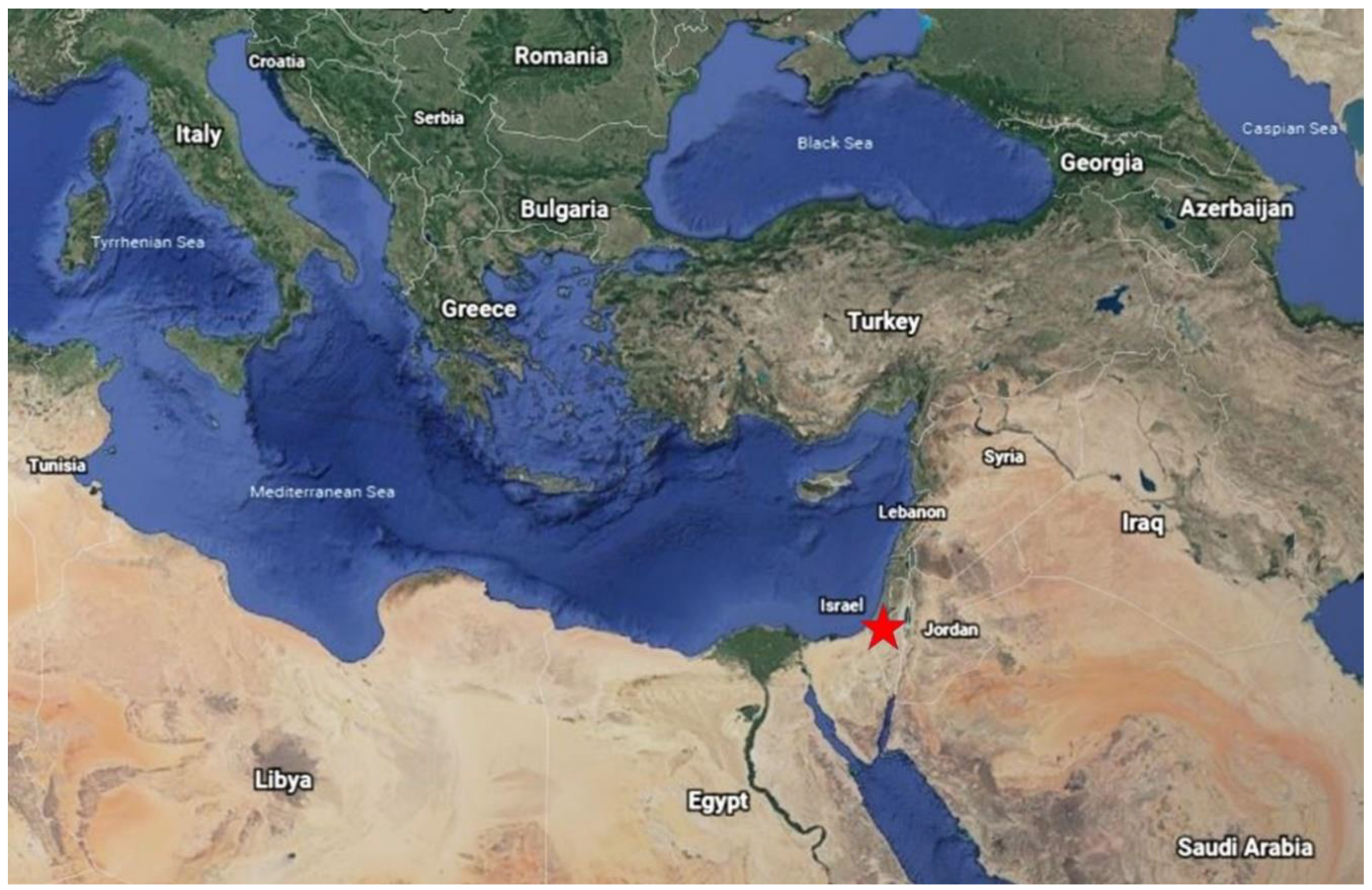
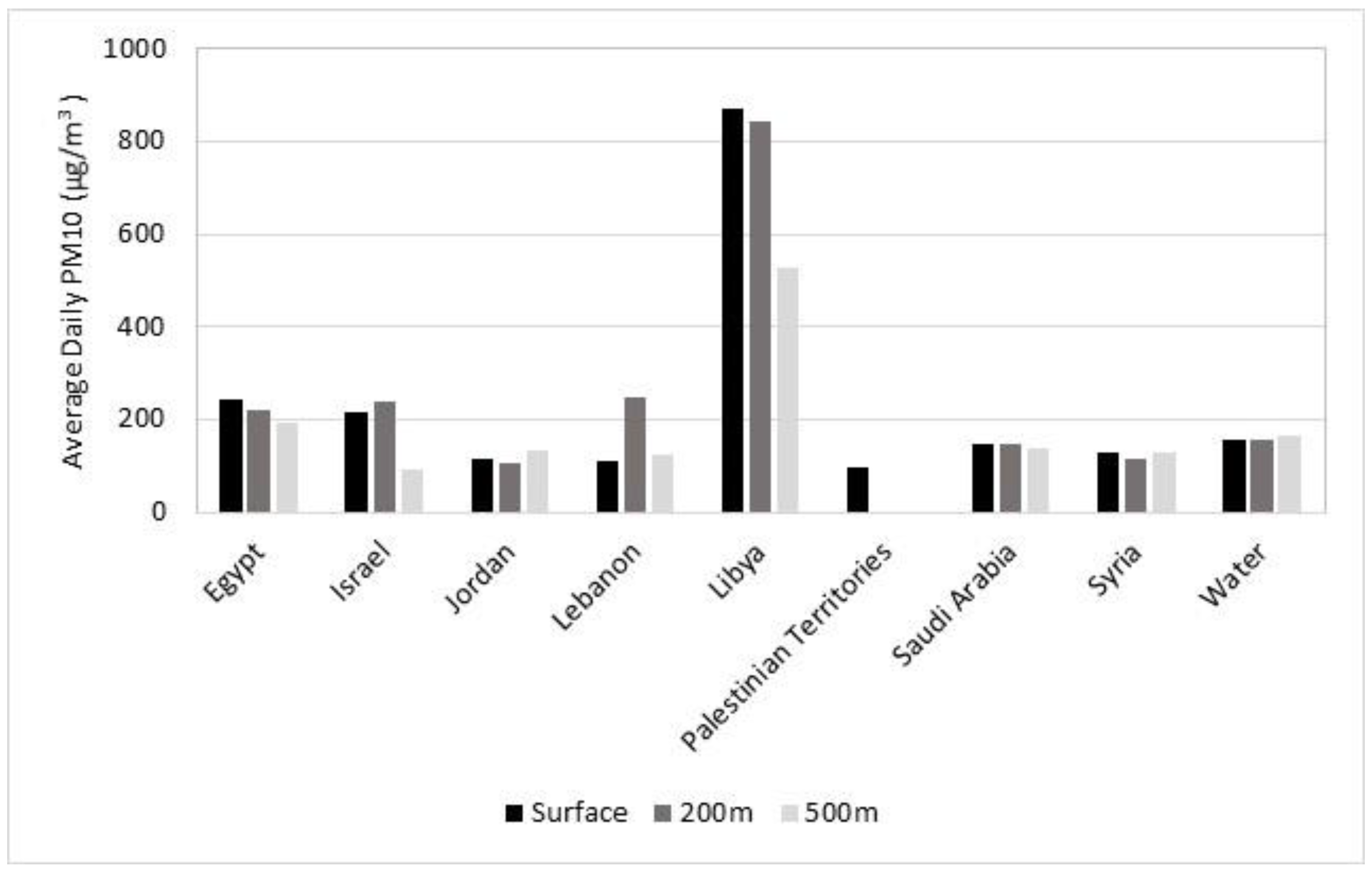
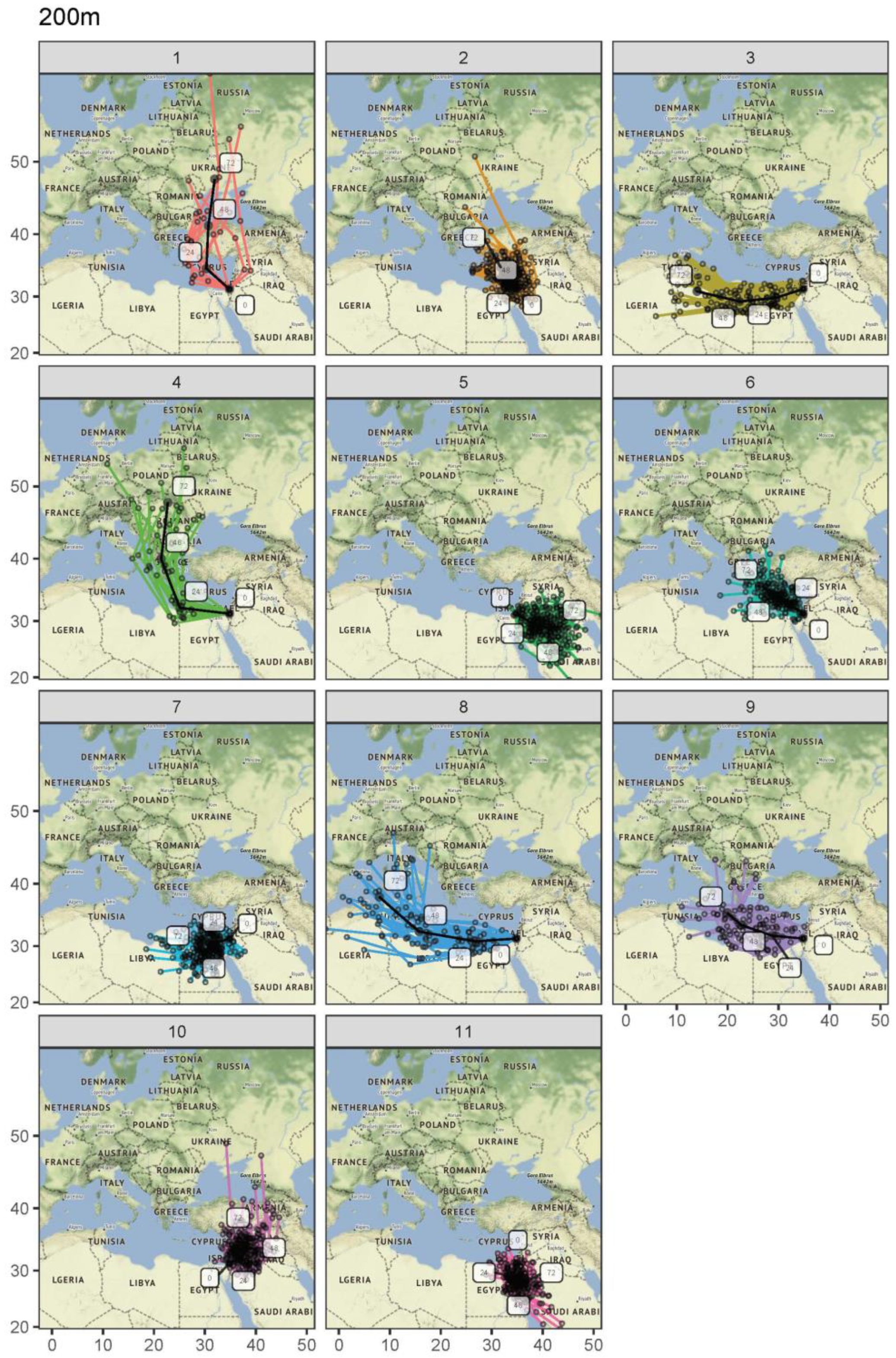
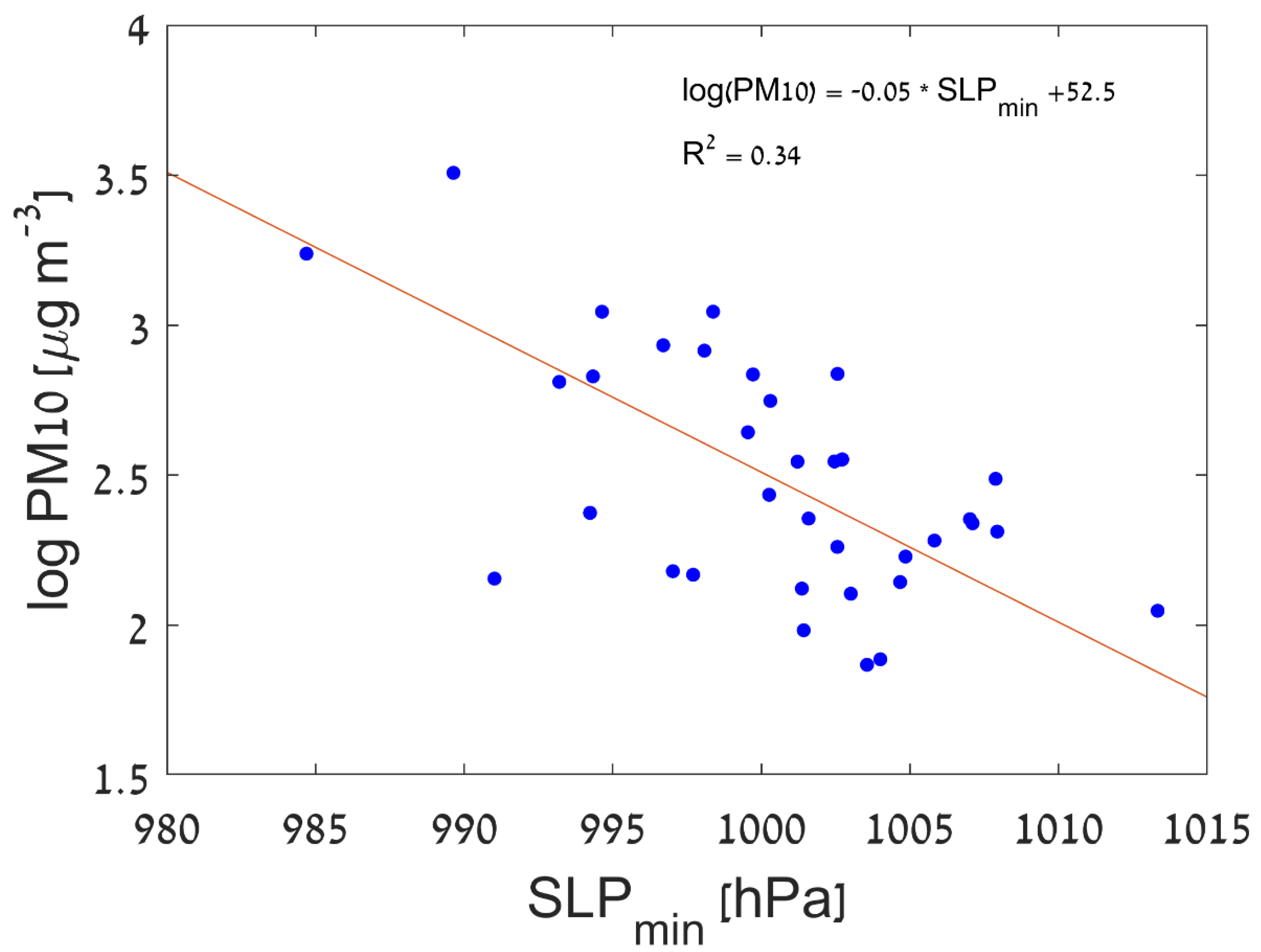
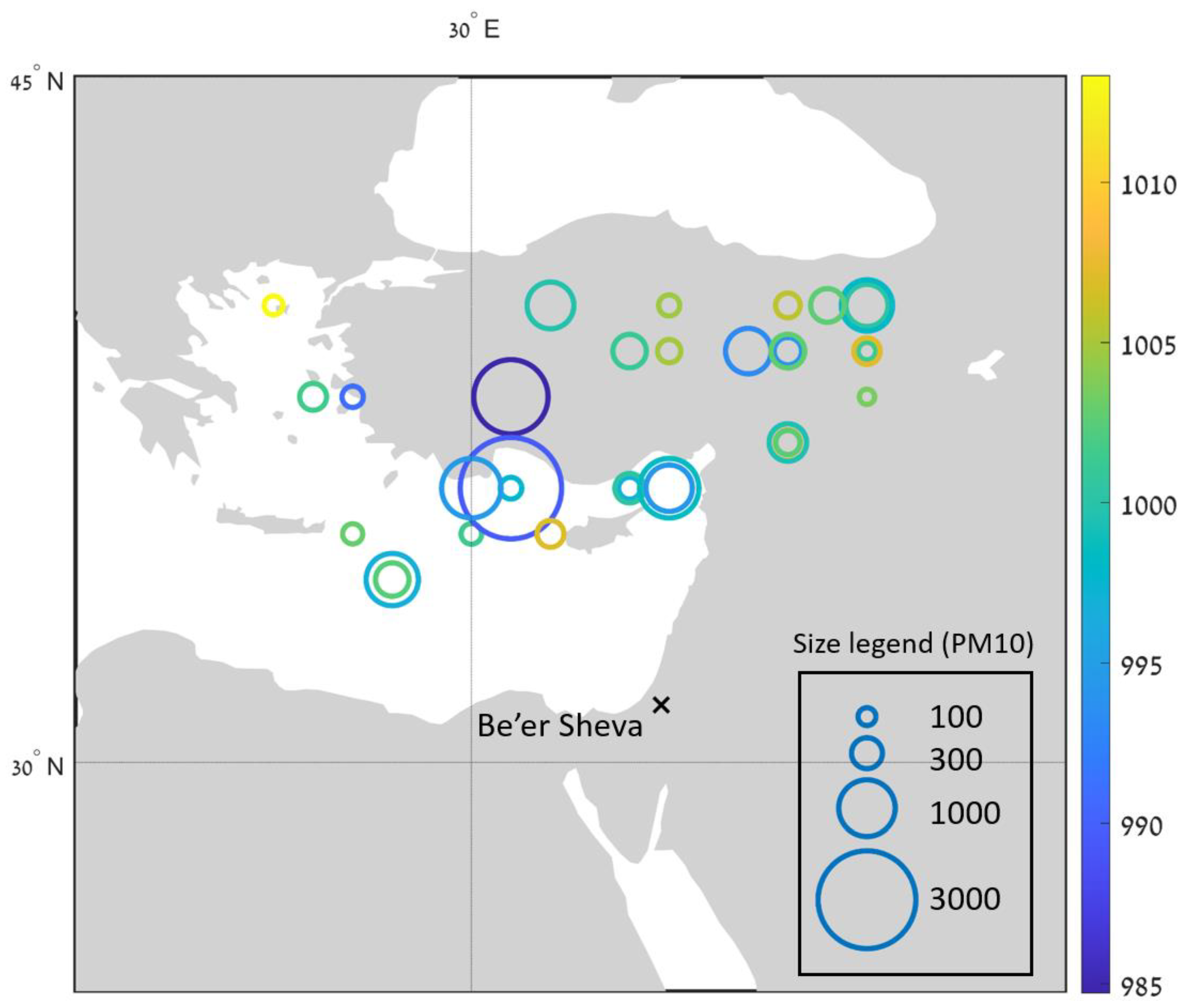
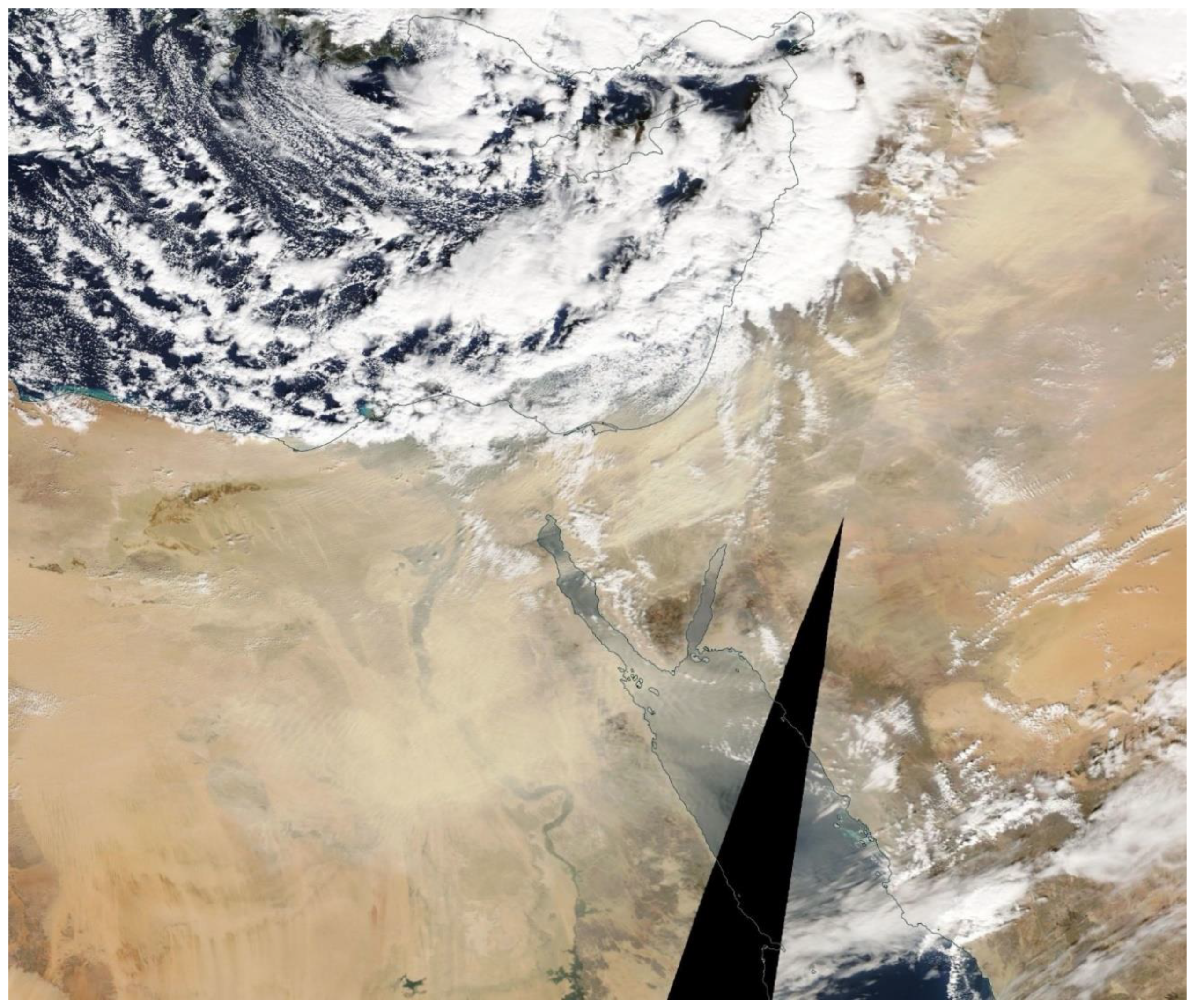
| Month | Average Dust Day Frequency (%) | Average Daily PM10 (µg/m3) |
|---|---|---|
| Jan | 15.1 (17.1) | 60.2 (116.1) |
| Feb | 23.0 (27.0) | 77.0 (121.6) |
| Mar | 19.6 (12.9) | 66.2 (98.2) |
| Apr | 21.9 (23.4) | 63.7 (80.4) |
| May | 15.5 (21.8) | 63.8 (122.5) |
| Jun | 6.1 (8.6) | 43.0 (23.0) |
| Jul | 2.5 (5.2) | 42.4 (12.9) |
| Aug | 2.5 (6.9) | 41.9 (11.8) |
| Sep | 5.4 (9.8) | 47.3 (80.1) |
| Oct | 13.4 (14.2) | 47.0 (33.6) |
| Nov | 14.6 (24.5) | 53.2 (64.4) |
| Dec | 18.5 (19.1) | 72.6 (193.1) |
| Cluster | Dust Days (n) | Average PM10 (µg/m3) |
|---|---|---|
| 1 | 11 | 113.8 (27.3) |
| 2 | 95 | 169.8 (212.6) |
| 3 | 46 | 224.1 (279.7) |
| 4 | 18 | 582.7 (708.0) |
| 5 | 83 | 121.8 (55.9) |
| 6 | 68 | 97.9 (35.2) |
| 7 | 83 | 180.7 (125.7) |
| 8 | 36 | 332.6 (352.5) |
| 9 | 37 | 210.4 (210.8) |
| 10 | 83 | 147.2 (177.9) |
| 11 | 69 | 175.0 (129.0) |
| Total | 629 | 181.2 (227.1) |
| Time (Local) | Temp (°C) | Relative Humidity (%) | Wind Speed (m/s) | Wind Direction (Degrees) | PM10 (µg/m3) |
|---|---|---|---|---|---|
| 600 | 11.4 | 47 | 6.3 | 240 | 4216 |
| 1200 | 10.1 | 43 | 7.3 | 237 | 2153 |
| 1800 | 12.0 | 41 | 8.1 | 238 | n/a |
| 2400 | 10.9 | 49 | 6.0 | 238 | 2982 |
© 2020 by the authors. Licensee MDPI, Basel, Switzerland. This article is an open access article distributed under the terms and conditions of the Creative Commons Attribution (CC BY) license (http://creativecommons.org/licenses/by/4.0/).
Share and Cite
Kalkstein, A.J.; Rudich, Y.; Raveh-Rubin, S.; Kloog, I.; Novack, V. A Closer Look at the Role of the Cyprus Low on Dust Events in the Negev Desert. Atmosphere 2020, 11, 1020. https://doi.org/10.3390/atmos11101020
Kalkstein AJ, Rudich Y, Raveh-Rubin S, Kloog I, Novack V. A Closer Look at the Role of the Cyprus Low on Dust Events in the Negev Desert. Atmosphere. 2020; 11(10):1020. https://doi.org/10.3390/atmos11101020
Chicago/Turabian StyleKalkstein, Adam J., Yinon Rudich, Shira Raveh-Rubin, Itai Kloog, and Victor Novack. 2020. "A Closer Look at the Role of the Cyprus Low on Dust Events in the Negev Desert" Atmosphere 11, no. 10: 1020. https://doi.org/10.3390/atmos11101020
APA StyleKalkstein, A. J., Rudich, Y., Raveh-Rubin, S., Kloog, I., & Novack, V. (2020). A Closer Look at the Role of the Cyprus Low on Dust Events in the Negev Desert. Atmosphere, 11(10), 1020. https://doi.org/10.3390/atmos11101020





